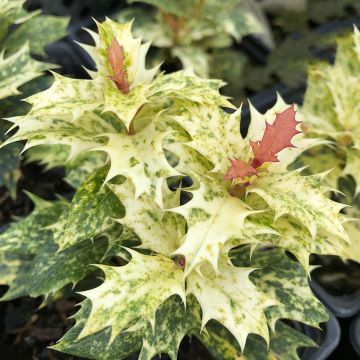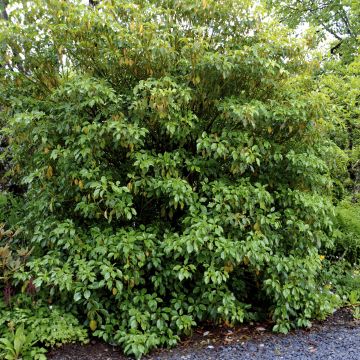

Osmanthus burkwoodii
Osmanthus burkwoodii
Osmanthus burkwoodii
Burkwood Osmanthus
This item cannot be shipped to the selected country
Delivery charge from €5.90
Delivery charge from €5.90
More information
Schedule delivery date,
and select date in basket
This plant carries a 24 months recovery warranty
More information
We guarantee the quality of our plants for a full growing cycle, and will replace at our expense any plant that fails to recover under normal climatic and planting conditions.
From €5.90 for pickup delivery and €6.90 for home delivery
Express home delivery from €8.90.
From €5.90 for pickup delivery and €6.90 for home delivery
Express home delivery from €8.90.


Does this plant fit my garden?
Set up your Plantfit profile →
Description
The Osmanthus Burkwoodii is a hybrid bush resulting from the cross-breeding of Osmanthus decorus and Osmanthus delavayi. With a compact habit, it has a long flowering period but grows slowly. From April to May the small white flowers emit a pleasant jasmine scent; it is one of the most fragrant spring flowers. The flowers are grouped in small clusters and measure 5mm (0.2in) in diameter. They have a short tube-like shape and are located at the base of the leaves. The evergreen foliage allows the plant to be decorative all year round thanks to its dark green and shiny colour and its slightly dentate oval shape. The leaves measure from 3 to 5 cm (1.2 - 2 in) in length.
Also known as Burkwood Osmanthus, named after its breeder, a famous English young plant grower from early last century. It can reach 3m (9.8ft) in height and width and is a very hardy bush. It is used in scented spring beds as well as in "countryside gardens" with lilacs, spireas, and forsythias. It is also seen in partial shade summer beds along with a syriacus hibiscus and a macrophylla hydrangea.
This bush can be planted as a hedge or as a standalone. It is grown in gardens or even on a terrace in a pot. In this case, it can serve as a windbreak or a privacy screen on the balcony, for example. Plant it near a pathway to fully enjoy its scent. It can be used for topiaries. The Osmanthus is from one of the ten specific research areas of China that has been cultivated for over 2000 years.
Report an error about the product description
Plant habit
Flowering
Foliage
Botanical data
Osmanthus
burkwoodii
Oleaceae
Burkwood Osmanthus
Cultivar or hybrid
Other Osmanthus
Planting and care
Place Osmanthus Burkwoodii in full sun or partial shade, avoiding cold winds but providing good airflow. It is a plant that loves heat and tolerates coastal conditions well. Plant it in ordinary, light, fertile, moist but well-drained soil. It tolerates all types of soil, except very dry soil. It is sensitive to severe cold and stagnant humidity. It can be planted all year round, except during freezing periods. Osmanthus plants that are used for hedges should be spaced 80cm (31.5in) to 1m (3.3ft) apart. If planting in a container, a depth of about 40cm (15.7in) is required. Osmanthus is easy to cultivate. Water generously at planting and then once or twice a week, to promote establishment, then continue to water regularly. Prune the branches after flowering to maintain a compact and bushy habit. Additionally, mulching the base allows the soil to stay moist. The bush tolerates severe pruning. However, it takes two years to flower abundantly again.
Planting period
Intended location
Care
-
, onOrder confirmed
Reply from on Promesse de fleurs
Evergreen shrubs
Haven't found what you were looking for?
Hardiness is the lowest winter temperature a plant can endure without suffering serious damage or even dying. However, hardiness is affected by location (a sheltered area, such as a patio), protection (winter cover) and soil type (hardiness is improved by well-drained soil).

Photo Sharing Terms & Conditions
In order to encourage gardeners to interact and share their experiences, Promesse de fleurs offers various media enabling content to be uploaded onto its Site - in particular via the ‘Photo sharing’ module.
The User agrees to refrain from:
- Posting any content that is illegal, prejudicial, insulting, racist, inciteful to hatred, revisionist, contrary to public decency, that infringes on privacy or on the privacy rights of third parties, in particular the publicity rights of persons and goods, intellectual property rights, or the right to privacy.
- Submitting content on behalf of a third party;
- Impersonate the identity of a third party and/or publish any personal information about a third party;
In general, the User undertakes to refrain from any unethical behaviour.
All Content (in particular text, comments, files, images, photos, videos, creative works, etc.), which may be subject to property or intellectual property rights, image or other private rights, shall remain the property of the User, subject to the limited rights granted by the terms of the licence granted by Promesse de fleurs as stated below. Users are at liberty to publish or not to publish such Content on the Site, notably via the ‘Photo Sharing’ facility, and accept that this Content shall be made public and freely accessible, notably on the Internet.
Users further acknowledge, undertake to have ,and guarantee that they hold all necessary rights and permissions to publish such material on the Site, in particular with regard to the legislation in force pertaining to any privacy, property, intellectual property, image, or contractual rights, or rights of any other nature. By publishing such Content on the Site, Users acknowledge accepting full liability as publishers of the Content within the meaning of the law, and grant Promesse de fleurs, free of charge, an inclusive, worldwide licence for the said Content for the entire duration of its publication, including all reproduction, representation, up/downloading, displaying, performing, transmission, and storage rights.
Users also grant permission for their name to be linked to the Content and accept that this link may not always be made available.
By engaging in posting material, Users consent to their Content becoming automatically accessible on the Internet, in particular on other sites and/or blogs and/or web pages of the Promesse de fleurs site, including in particular social pages and the Promesse de fleurs catalogue.
Users may secure the removal of entrusted content free of charge by issuing a simple request via our contact form.
The flowering period indicated on our website applies to countries and regions located in USDA zone 8 (France, the United Kingdom, Ireland, the Netherlands, etc.)
It will vary according to where you live:
- In zones 9 to 10 (Italy, Spain, Greece, etc.), flowering will occur about 2 to 4 weeks earlier.
- In zones 6 to 7 (Germany, Poland, Slovenia, and lower mountainous regions), flowering will be delayed by 2 to 3 weeks.
- In zone 5 (Central Europe, Scandinavia), blooming will be delayed by 3 to 5 weeks.
In temperate climates, pruning of spring-flowering shrubs (forsythia, spireas, etc.) should be done just after flowering.
Pruning of summer-flowering shrubs (Indian Lilac, Perovskia, etc.) can be done in winter or spring.
In cold regions as well as with frost-sensitive plants, avoid pruning too early when severe frosts may still occur.
The planting period indicated on our website applies to countries and regions located in USDA zone 8 (France, United Kingdom, Ireland, Netherlands).
It will vary according to where you live:
- In Mediterranean zones (Marseille, Madrid, Milan, etc.), autumn and winter are the best planting periods.
- In continental zones (Strasbourg, Munich, Vienna, etc.), delay planting by 2 to 3 weeks in spring and bring it forward by 2 to 4 weeks in autumn.
- In mountainous regions (the Alps, Pyrenees, Carpathians, etc.), it is best to plant in late spring (May-June) or late summer (August-September).
The harvesting period indicated on our website applies to countries and regions in USDA zone 8 (France, England, Ireland, the Netherlands).
In colder areas (Scandinavia, Poland, Austria...) fruit and vegetable harvests are likely to be delayed by 3-4 weeks.
In warmer areas (Italy, Spain, Greece, etc.), harvesting will probably take place earlier, depending on weather conditions.
The sowing periods indicated on our website apply to countries and regions within USDA Zone 8 (France, UK, Ireland, Netherlands).
In colder areas (Scandinavia, Poland, Austria...), delay any outdoor sowing by 3-4 weeks, or sow under glass.
In warmer climes (Italy, Spain, Greece, etc.), bring outdoor sowing forward by a few weeks.






















































